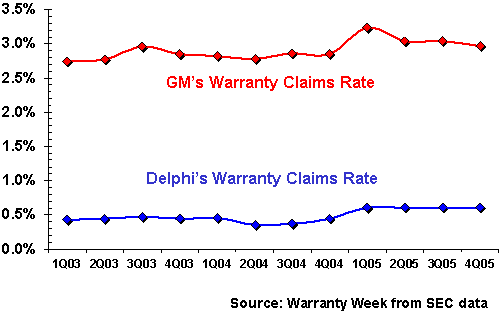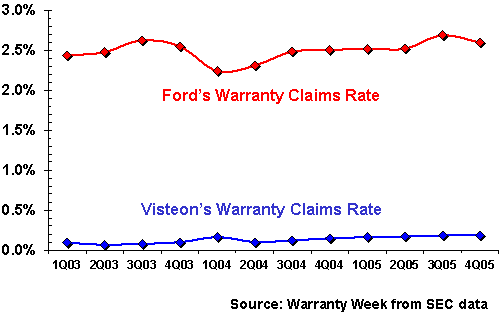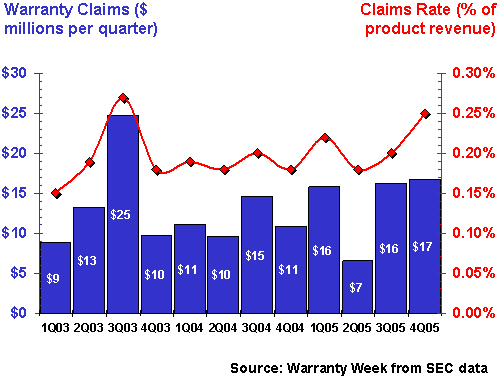April 25, 2006 |

|
ISSN 1550-9214 |
Automotive Warranties:While GM and Ford spend the most on warranty, other types of vehicle manufacturers pay out a greater share of their total revenue on claims. And while most parts suppliers have relatively low claims rates, those in the aftermarket report some of the highest rates of all.Automotive manufacturers reported more than $12.5 billion in warranty claims for calendar 2005, up more than 8.2% from 2004 levels. As high as this sounds, it still represents less than 2% of automotive product revenue, as it has in all but one of the past twelve quarters. What's more worrisome is the stubborn gap between the warranty claims rates reported by the major OEMs and their suppliers. While the OEMs typically pay out 2.5% to 2.7% of their revenue to honor warranty claims, their suppliers average only 0.5% to 0.7%. And that 2% gap has remained in place, more or less, for all of the last three years. But at least it's not widening. Warranty Week is tracking roughly 180 companies that provide product warranties for vehicles or for the parts and components that go into vehicles. Of those, 144 are primarily automotive companies and 36 are primarily in some other industry such as aerospace, consumer electronics, semiconductors, or telecommunications. GM & Ford DominateGeneral Motors Corp. and the Ford Motor Company are by far the largest warranty providers on the list. Together they paid out almost $8.7 billion last year in warranty claims, up from $8.3 billion in 2004. But amazingly, their share of the total automotive warranty pie fell below 70% in 2005, after remaining above that level in both 2003 and 2004. That means everybody else's warranty expenses are rising a little bit faster than Ford's and GM's. The gap is perhaps best illustrated by direct comparisons between the passenger car giants and their spin-offs. GM spun off Delphi Corp. in 1999, and Ford spun off Visteon Corp. in 2000. Right now, GM is roughly six times larger than Delphi in terms of revenue, but it pays out 30 times as much as its spin-off in warranty claims. Likewise, Ford is about eight times larger than Visteon, but pays out almost 160 times as much in warranty claims. As the graphics below illustrate, the gap isn't closing. While General Motors has seen its claims rate rise above 3% this year, Delphi's remains closer to 0.6%. While the comparison of one company to another may not be entirely appropriate, given the possible differences in their respective warranty accounting systems and methodologies, we think in this instance it's more like comparing a parent to a child. Figure 1 | |||||||||||||||||||||||||||||||||||||||||||||||||||||||||||||||||||||||||||||||||||||||||||||||||||||||||||
| Back to Part One | Go to Part Three |

|
This Week’s Warranty Week Headlines | ||
|
Diebold Election Systems will void its warranty if any third party tests or inspects its voting machines. Tallahassee Democrat, April 25, 2006 | ||
|
GM of Canada reacts to a class action lawsuit filed against it over faulty intake manifold gaskets. Soonews.ca, April 25, 2006 | ||
|
Canon fails to notify U.S. customers about so-called e18 defect, demands payments for repairs. Consumer Affairs, April 24, 2006 | ||
|
Sewer manufacturer tells town it will not honor its warranty if the streets aren't paved to guard manholes and air seals. Newburyport Daily News, April 24, 2006 | ||
|
Wilson's Suede & Leather drops lifetime warranties; retailer says it was not cost-effective. San Jose Mercury News, April 24, 2006 | ||
More Warranty Headlines below | ||

|
Warranty Headlines (cont’d) | ||
|
Attorney says PrimeGuars backed 40,000 extended warranty policies sold by 1Source and First Assured. Hartford Courant, April 22, 2006 | ||
|
Toshiba to repair laptop for 15th time in three years; declines to replace the unit. Orlando Sentinel, April 21, 2006 | ||
|
National Association of Home Builders publishes new book, Warranties for Builders and Remodelers. Building Online, April 20, 2006 | ||
|
Godrej & Boyce gives its refrigerators a 10-year warranty against rusting. Domain B, April 20, 2006 | ||
|
Extended warranties bought from defunct Autolines Inc. honored at other repair shops. Brockton Enterprise, April 19, 2006 | ||
More Warranty Headlines below | ||

|
Warranty Headlines (cont’d) | ||
|
Synergix to sell extended warranties with four-day turnarounds at a cost of 2% of product price. Barcode Resellers, April 19, 2006 | ||
|
HH Robertson Asia/Pacific Group picks Industrial Nanotech because the company was willing to back its metal coatings with a warranty. Press Release, April 18, 2006 | ||
|
Dealers Assurance Company appoints Kirk A. Borchardt as chief executive officer and Mohammad H. Mithani as vice president. Press Release, April 17, 2006 | ||
|
City of Rock Hill, SC, picks CNH backhoe-loaders because of warranty policies. Equipment Today, April 15, 2006 | ||
|
Polaris Industries says sales fell after increased warranty claims lowered dealer confidence in its snowmobiles. Reuters, April 13, 2006 | ||
More Warranty Headlines below | ||

|
Warranty Headlines (cont’d) | ||
|
Mercedes wants to reduce warranty claims for the E-Class to a level lower than Toyota's. What Car?, April 13, 2006 | ||
|
The Exotic Warranty Company to be liquidated by a Circuit Court in Florida; company sold insurance without a license. Official Announcement, April 12, 2006 | ||
|
DaimlerChrysler Canada president says warranty costs have been cut 40% in the past decade. Toronto Globe and Mail, April 11, 2006 | ||
|
Vermont attorney general's office closes Dydo Auto Sales after numerous fraud allegations. Rutland Herald, April 11, 2006 | ||
|
Jigsaw Insurance Marketing (Wales) Ltd. to add 100 extended warranty telemarketing jobs in a new call center. Western Mail, April 11, 2006 | ||
More Warranty Headlines below | ||
|
|
Warranty Headlines (cont’d) | ||
|
Navistar dismisses its auditors, delays annual report, and will restate earnings and warranty reimbursements. CFO Magazine, April 10, 2006 | ||
|
Apple says installing Boot Camp, its new Windows XP software, does not invalidate a Mac's warranty. Macworld, April 10, 2006 | ||
|
Cayman Automotive Marketing to offer vehicle service contracts in the Cayman Islands. Cayman Net News, April 10, 2006 | ||
|
Columnist says the 1998-2002 V6-powered Honda Accord is a problem-prone car. Toronto Star, April 8, 2006 | ||
|
GM to cooperate with Delphi's creditors, but still says it's owed money for warranty and product recall claims. Associated Press, April 7, 2006 | ||
More Warranty Headlines below | ||

|
Warranty Headlines (cont’d) | ||
|
Consumer Reports gives four of five Nissan and Infiniti models built in Mississippi the lowest possible reliability ratings. Bloomberg News, April 7, 2006 | ||
|
Truck needs a new engine but Dodge says the warranty was voided by a lack of oil change documentation. WSAV-TV Savannah, April 7, 2006 | ||
|
Azerbaijan's Antimonopoly Policy Department suspects non-warranted mobile phones are being sold. Azerbaijan Today, April 6, 2006 | ||
|
Warranted garbage cans are disappearing in Nashville, homeless thieves suspected. The Tennessean, April 5, 2006 | ||
|
Hiking boots' "lifetime" warranty ended when the company was bought. Seattle Post Intelligencer, April 5, 2006 | ||
|
Service Net Solutions to administer all extended warranty programs for Tweeter Home Entertainment Group. Press Release, April 4, 2006 | ||
|
Western Digital to deliver under-warranty hard drive replacements directly to homes and businesses. Channel Times, April 4, 2006 | ||
More Warranty Headlines | ||
Related Articles From Warranty Week |






